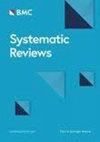脊骨神经治疗对非癌症脊柱疼痛处方阿片类药物使用的影响:系统回顾和荟萃分析方案
IF 6.3
4区 医学
Q1 MEDICINE, GENERAL & INTERNAL
引用次数: 0
摘要
在最近的研究中,接受脊骨神经治疗与非癌症脊柱疼痛患者接受阿片类药物处方的几率降低,以及在已开具处方的患者中减少阿片类药物的剂量有关。这些研究结果表明,接受脊骨神经治疗可减少肌肉骨骼疼痛患者对阿片类药物的依赖。目的:评估脊骨神经治疗对非癌症脊柱疼痛患者开始或继续使用处方阿片类药物的影响。我们将检索符合条件的随机对照试验(RCT)和观察性研究,这些研究将在 MEDLINE、Embase、AMED、CINAHL、Web of Science 和《脊骨神经医学文献索引》(Index to Chiropractic Literature)中收录,检索期从数据库开始至 2024 年 6 月。文章筛选、数据提取和偏倚风险评估将由一对审稿人独立完成。我们将对研究性临床试验和观察性研究分别进行分析,并将二元结果(如处方阿片类药物接收、长期使用阿片类药物、阿片类药物剂量高与低等)汇总为几率比(OR)及相关的 95% 置信区间(CI)。如果研究提供了时间到事件数据(如首次开具阿片类药物处方的时间)的危险比(HRs)或相对危险度(RRs)或发病率(一段时间内开具阿片类药物处方的数量),我们将首先将其转换为 OR,然后再进行汇总。疼痛强度、睡眠质量或吗啡当量剂量等连续性结果将以加权平均差及相关 95% CI 的形式进行汇总。我们将使用随机效应模型进行荟萃分析,并使用亚组分析和元回归探讨异质性的来源。我们将采用 GRADE 方法评估所有结果的证据确定性,并采用 ICEMAN 标准评估所有亚组效应的可信度。我们的系统综述将遵循 PRISMA 声明和 MOOSE 指南。我们的综述将建立当前的证据,说明脊骨神经治疗对非癌症脊柱疼痛的新处方或持续处方阿片类药物使用的影响。我们将通过同行评议刊物和会议演讲传播我们的研究成果。我们的研究结果将引起患者、医疗服务提供者和政策制定者的兴趣。系统综述注册:ProCORMBERCO CRD42023432277.本文章由计算机程序翻译,如有差异,请以英文原文为准。
The impact of chiropractic care on prescription opioid use for non-cancer spine pain: protocol for a systematic review and meta-analysis
In recent studies, receipt of chiropractic care has been associated with lower odds of receiving prescription opioids and, among those already prescribed, reduced doses of opioids among patients with non-cancer spine pain. These findings suggest that access to chiropractic services may reduce reliance on opioids for musculoskeletal pain. To assess the impact of chiropractic care on initiation, or continued use, of prescription opioids among patients with non-cancer spine pain. We will search for eligible randomized controlled trials (RCTs) and observational studies indexed in MEDLINE, Embase, AMED, CINAHL, Web of Science, and the Index to Chiropractic Literature from database inception to June 2024. Article screening, data extraction, and risk-of-bias assessment will be conducted independently by pairs of reviewers. We will conduct separate analyses for RCTs and observational studies and pool binary outcomes (e.g. prescribed opioid receipt, long-term opioid use, and higher versus lower opioid dose) as odds ratios (ORs) with associated 95% confidence intervals (CIs). When studies provide hazard ratios (HRs) or relative risks (RRs) for time-to-event data (e.g. time-to-first opioid prescription) or incidence rates (number of opioid prescriptions over time), we will first convert them to an OR before pooling. Continuous outcomes such as pain intensity, sleep quality, or morphine equivalent dose will be pooled as weighted mean differences with associated 95% CIs. We will conduct meta-analyses using random-effects models and explore sources of heterogeneity using subgroup analyses and meta-regression. We will evaluate the certainty of evidence of all outcomes using the GRADE approach and the credibility of all subgroup effects with ICEMAN criteria. Our systematic review will follow the PRISMA statement and MOOSE guidelines. Our review will establish the current evidence informing the impact of chiropractic care on new or continued prescription opioid use for non-cancer spine pain. We will disseminate our results through peer-reviewed publication and conference presentations. The findings of our review will be of interest to patients, health care providers, and policy-makers. Systematic review registration: PROSPERO CRD42023432277.
求助全文
通过发布文献求助,成功后即可免费获取论文全文。
去求助
来源期刊

Systematic Reviews
Medicine-Medicine (miscellaneous)
CiteScore
8.30
自引率
0.00%
发文量
241
审稿时长
11 weeks
期刊介绍:
Systematic Reviews encompasses all aspects of the design, conduct and reporting of systematic reviews. The journal publishes high quality systematic review products including systematic review protocols, systematic reviews related to a very broad definition of health, rapid reviews, updates of already completed systematic reviews, and methods research related to the science of systematic reviews, such as decision modelling. At this time Systematic Reviews does not accept reviews of in vitro studies. The journal also aims to ensure that the results of all well-conducted systematic reviews are published, regardless of their outcome.
 求助内容:
求助内容: 应助结果提醒方式:
应助结果提醒方式:


